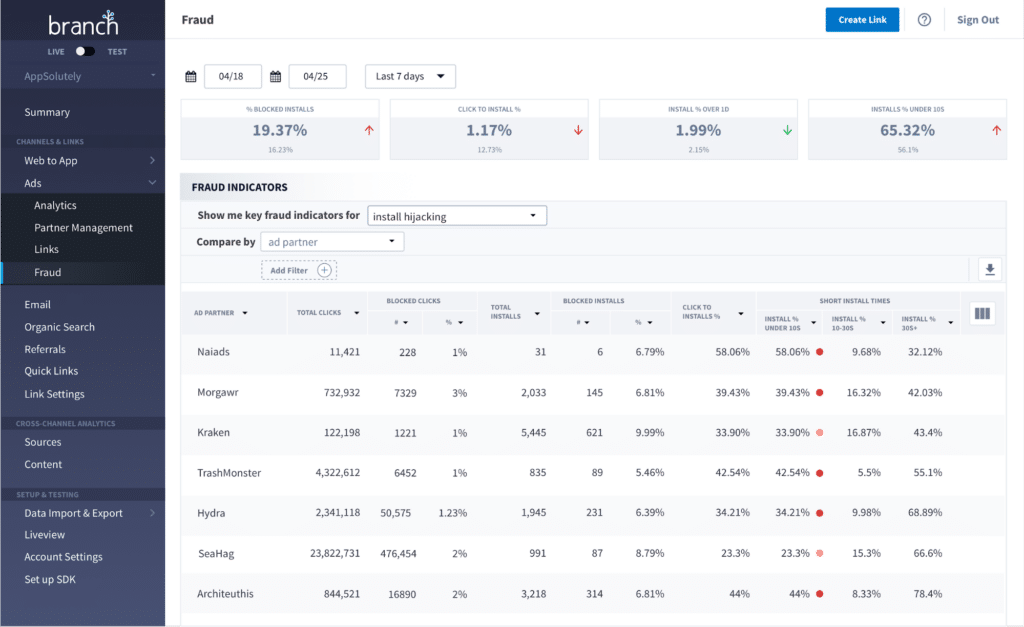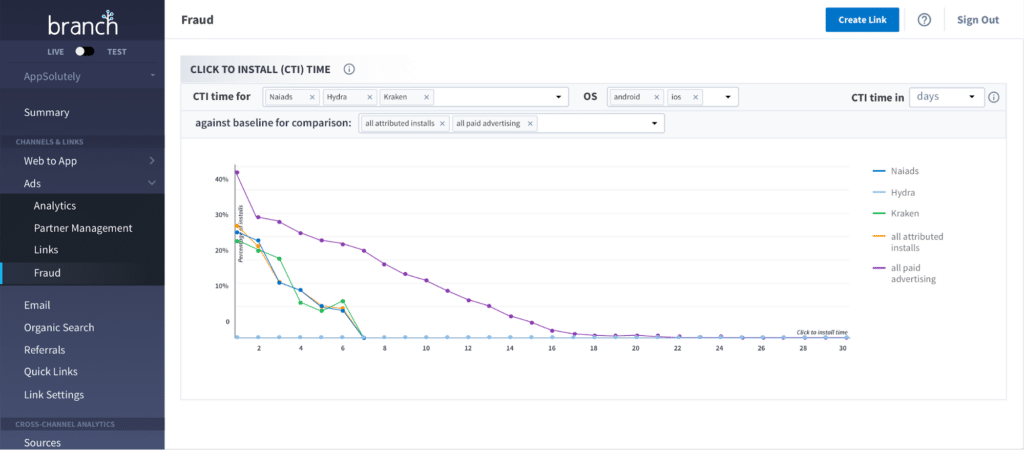The numbers are staggering, and you’ve likely heard them before: Mobile ad fraud is growing, and it’s costing marketers billions.
According to Juniper Research, overall ad fraud is estimated to cost marketers $19 billion this year—and that number is projected to hit $44 billion by 2022.
When we narrow the focus to mobile ad fraud, the data doesn’t get much more promising. According to Mobilewalla, fraudulent mobile data ran up a $16 billion marketing tab in 2017. Mobilewalla also found that 87% of devices passed through programmatic mobile in the U.S. were fraudulent.
There are number of ways mobile and click fraud can and does work—and it’s most common outside of the walled gardens of Facebook, Google, and Apple’s mobile ad offerings.
Buying outside of those three networks is alluring because marketers can more easily customize and target users with personalized creative that drives conversions—but those outside networks are also a much bigger source of fraudulent installs, click-flooding, and other nefarious fraudster tactics.
These statistics—and the state of mobile ad fraud—put marketers in a tough position. It’s universally acknowledged that there’s a massive amount of mobile ad fraud occurring in the mobile space—but what steps can marketers take today to ensure their mobile advertising budgets aren’t being funneled directly to click-fraud criminals?
How to Find the Right Mobile Ad Fraud Prevention Partner
The best partners in mobile serve as the first line of defense against mobile ad fraud. In the world of fraud, there are known bad IPs—like a user coming from a Tor network, a user going through a known public proxy to hide their source, or other bots programmed to commit mobile ad fraud.
For those instances of mobile ad fraud, it’s important to have a technology partner that can immediately spot and block those installs. Finding the right partner is the first step toward preventing mobile fraud, the fastest way to protect your data, and a key part of determining your real mobile ad attribution.
Finding the right partner is one of the first boxes you will want to check off in your efforts to stop mobile ad fraud—and the more fraud detection can be handled programmatically, the better.
How to Uncover Click and Install Fraud Within Your Data
The key to detecting mobile ad fraud is usually in your data. Numbers will tell you a lot—but that means you have to search for the right stats, which can be a challenge without the right data at your disposal.
- Install Hijacking
In this scenario, mobile malware on a user devices hijacks attribution for an app install. For instance, let’s say a user installs an app on an Android device with mobile malware installed. The malware can immediately fire off a click the second it has determined that an app has been installed in another place on a device. In this scenario, it would appear, to the network, that there was an install—but in reality, the install has happened organically and the malware is taking credit for the install.
- Click Flooding
Click flooding typically happens when a bot cycles through as many device IDs as possible and fires off clicks from every single ID repeatedly. Fraudsters may set the goal to generate 20B clicks over the span of one week. Within this one-week window, if any of the devices happen to have any organic app install events, these randomly generated clicks claim the credit. This is an example of click fraud. Alternatively, users may have installs triggered by real clicks on ads. Fraudsters may hit the jackpot if their fake clicks happen to follow the real click and precede the completed installation of a mobile app, thereby claiming the last touch grand prize. - Click-to-Install Time (CTIT)
The time between when a user clicks to download your app and the time the app is installed can be incredibly revealing—and it’s one important aspect of detecting mobile ad fraud. Exceptionally short click-to-install times (under one second, for example) can be a huge red flag when monitoring click-to-install time data because the interval is far too small to be realistic in most cases.
Through the Branch dashboard, our clients are able to find and act on key areas of mobile ad fraud detection.
How to Leverage Cross-Channel Behaviors to Stop Mobile Click Fraud
Most mobile ad providers cover the fundamental bases to protect their clients from fraud. But there’s a new variable that can make a huge difference in your efforts to decrease instances of fraud: cross-channel behaviors.
Users’ behavior can be a huge indicator of fraud—especially across channels. The ability to compare cohorts across paid and non-paid advertising channels is critical for marketers who want to reduce instances of mobile ad fraud to create a clearer, more confident picture of their attribution.
Branch helps partners understand the baseline of their users’ normal behaviors across channels, such as install times and click rates. When behaviors outside of the norm arise across channels, Branch flags the instance as potentially fraudulent.
Mobile Ad Fraud in Action
Let’s take a look at an example. Let’s say four users click on a paid ad placement to download your mobile app. Three of those users display normal behaviors—they exhibit standard click-to-install times, and the average number of apps they download in a month is consistent with an average user. But the third person that downloads your app has fifty other apps installed, and never opens any of them. Based on normal cohort behavior, this user is more likely to be an instance of mobile fraud.
Ultimately, there’s no silver bullet when it comes to mobile ad fraud. However, there are plenty of steps marketers can take to reduce their instances of fraud, including working with partners like Branch to find trends in data across channels and to spot mobile ad fraud before it consumes even more dollars in your precious annual marketing budget.
Ready to learn more about how Branch can help you reliably and consistent fight mobile ad fraud? Request a demo to meet one-on-one with one of our mobile growth experts.
























